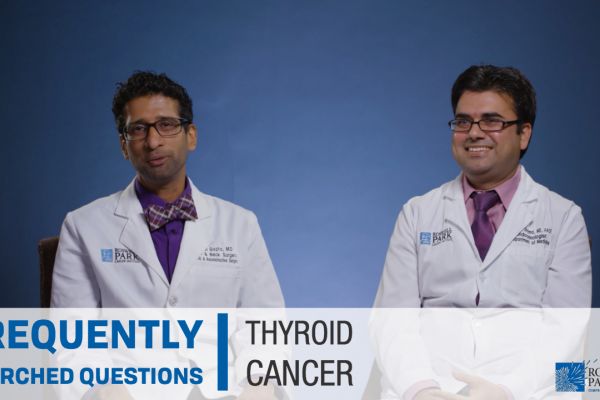The thyroid is a butterfly-shaped gland in the throat, just above the collarbone, that provides hormones important to supporting a healthy metabolism.
Thyroid cancer is a common occurrence, happening more often in women than men, but it remains a very treatable disease when diagnosed.
“Thyroid cancer, in most people, is asymptomatic,” says Vishal Gupta, MD, a physician in the Head & Neck and Plastic & Reconstructive Surgery Department at Roswell Park Comprehensive Cancer Center. “If it’s an advanced disease, people may present with hoarseness of voice, difficulty swallowing or sometimes they might feel a fullness or mass in their neck or a tumor that has spread to a lymph node.”
Pain, however, is not usually associated with thyroid cancer, Dr. Gupta says. But if someone feels a lump in their throat or neck, it’s worth going to a primary care physician to have them take a look and possibly schedule a sonogram to look for nodules in the throat.
Thyroid nodules are very common throughout the general population. It does not necessarily mean they are cancerous. Most of them will be benign, Dr. Gupta says. Patients with family history of thyroid cancer or a history of exposure to radiation are more at risk of developing this type of cancer. Until 1955, radiation was used for acne and tonsilitis, and that was one of the factors causing thyroid cancer, but that practice has long been replaced. Usually, a sonogram is warranted in patients noted to have midline neck mass to further evaluate for the need for biopsy.
Thyroid cancer info sheet
Know the symptoms and how to inspect your thyroid for bulges and protrusions that can help lead to early diagnosis.
Learn MoreExamining nodules will help determine risk
Most patients who come to Roswell Park are diagnosed by their family doctors based upon an annual exam, ultrasound or as a work up for palpable neck mass.
Nodules are usually benign, slow-growing and painless. If a doctor finds one or more nodules greater than 1 centimeter in size, that might be an indication for further workup. Sometimes, if a person has a chest x-ray or CT scan, their thyroid might be included in the photos, and occasionally nodules are picked up on PET imaging too.
“All patients with nodules should undergo a sonogram just to see,” Dr. Gupta says. “The sonogram looks at characteristics of the nodules and, based on those characteristics, assigns it one of five risk categories.”
Each characteristic gets a certain number of points. These points assign them to a certain risk category requiring observation or biopsy. For example; if the total number of points adds up to three, it’s considered a mildly suspicious risk category. More points will push it into moderately- and highly-suspicious categories. A cystic nodule, which is filled with fluid, has a very low risk of malignancy. If the nodule is solid, has a calcification or extra-thyroid extensions, those add up to more points and a higher suspicious risk category.
What happens next – biopsy or continued observation — will depend on the risk category and the size of the nodule. Moderately and highly suspicious nodules should get biopsied, as well as less-suspicious but larger nodules.
What happens after the biopsy
Even if it is determined that a nodule is cancerous, there’s usually time before treatment decisions have to be made. These treatment decisions are usually based upon National Comprehensive Cancer Network guidelines. Typically, with the diagnosis of thyroid cancer, surgical removal is preferred. But there is increasing trend towards watchful observation of very small tumors.
“The guidelines for thyroid cancer have changed quite a bit,” Dr. Gupta says. “Nowadays, if the thyroid cancer is limited to a single lesion, less than 1 cm or sometimes less than 1.5 cm, people do observe without operating. This is a slow-growing tumor, it doesn’t spread, it usually stays in the thyroid. This is not the worst kind of cancer.
Never miss another Cancer Talk blog!
Sign up to receive our monthly Cancer Talk e-newsletter.
Sign up!“But being a physician at a cancer center, I see both ends of the spectrum. Papillary thyroid cancer has different variants, like a rainbow. At one end is very benign, slow-growing tumors. On the other end is a very aggressive tumor, fast growing, capable of spreading to the lungs, lymph nodes and invading the local structure. I review imaging and pathological findings with patients and discuss various treatment options including surgical as well watchful observation if feasible.”
Due to high prevalence of thyroid cancer, some people may live for years without any impact on quality as well longevity of life.
Thyroid cancer has no screening test and does not present with any pain or obvious symptoms, Dr. Gupta says. “I don’t recall that I have ever seen patients with a pain in their neck who had cancer. Usually it’s some kind of inflammation. Cancer doesn’t usually present with painful symptoms.”



